A decade ago a striker’s job was simple – to score goals. Whilst this is still largely the case, over time as tactics have evolved, a striker’s measure of success can no longer be quantified by the commodity of goals. Any football fan you ask will now be able to reel off a multitude of various duties a striker can be enlisted to perform, beyond that of sticking the ball in the net. As a result, it’s become a case for dispute as to whether a striker who isn’t scoring goals is still worth their place in the team as the goal metric is no longer reliable to illustrate whether a striker is (under)performing.
Roberto Firmino is a striker who often falls in this grey area. His ability on and off the ball was long unnoticed, until a few seasons ago where he became notoriously underrated. With his false-nine positioning and ability to knit attacks together from enclosed central areas, Firmino’s goal scoring record occasionally dwindled which, to bloggers delight earned him the public title of being seriously underrated.
This season has had a different feel however for the Brazilian who has failed to score at Anfield in the league. With his side now not being as prolific as seasons past, this tactical analysis provides a scout report into Firmino to decipher whether the false-nine has moved from underrated to underperforming.
Traditional Metrics
To curate this analysis, I have taken the player statistics from all the top strikers across Europe, looking in particular at the domestic league games in the 2019/20 season. By analysing the top strikers and comparing their figures to Firmino’s we’ll be able to see where the Brazilian ranks amongst the worlds best.
Note that with the comparisons being against the very best – which is how Firmino should be measured – the results don’t necessarily mean poor performance, just worse than the elite – context is key.
To begin, I started with the traditional metrics of a striker – goalscoring. The graph below measures each striker’s Expected Goals per 90mins (xG90) and cross-references it against their shots on target per 90mins (Sh90). The size of each marker is dictated by the average number of goals per 90 of each player, therefore, the more goals, the bigger the marker.
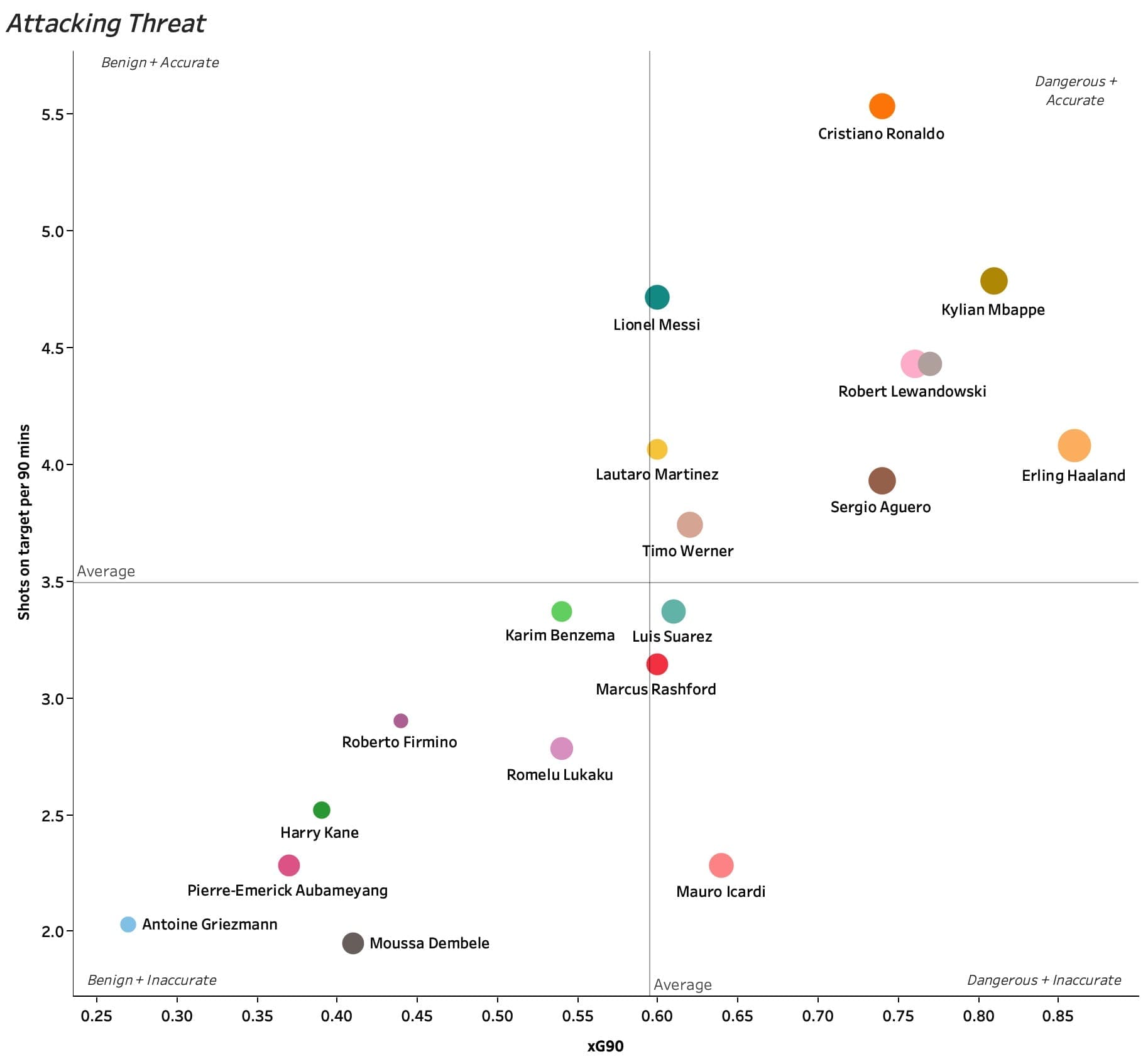
The results are clear in terms of how Firmino stacks up against his rivals. With an xG90 of just 0.44, Firmino sits in the lower quadrant, under the average set by his peers of 0.595. If we compare this to Timo Werner of RB Leipzig, who has been linked to Liverpool in the last few months, Firmino is outperformed by Werner’s xG90 of 0.62. We can also see that Firmino is registering fewer shots on target per match than his counterparts. The Brazilian’s 2.9 attempts on target again fall under the average line and is greatly overshadowed by the majority of other strikers – see Cristiano Ronaldo’s Sh90 of 5.53.
This will likely have something to do with the role undertaken in Jürgen Klopp’s system, with Firmino dropping deeper and linking attacks more frequently than blinkered goal-hungry strikers. Further to this, the graph doesn’t show the average xG per shot on target. As we know, fewer higher quality shots are more successful in the long run compared to a higher quantity of lower shots. What it does show, however, is that even if Firmino is 100% accurate with his shooting, there’s still a suppression – be it in the style of Liverpool’s approach or Firmino’s ability to find shooting space – on the number of attempts the number-9 is having. As a result, we can see Firminio’s marker is the smallest on the graph, averaging just 0.28 goals per 90.
The first test wasn’t overly surprising; Firmino is renowned for recreating the number-9 role and whilst the results continue to go in Liverpool’s favour, with other players benefiting from his unselfishness, Klopp won’t be too worried about the goal tally of his main man.
Chance Creation
But what if we measure Firmino on his strengths and pit those metrics against other strikers across Europe. Surely then, the Brazilian’s value to Liverpool’s success would start to become more apparent.
The graph below looks at each striker’s average forward pass completion percentage per 90 (Fp90) mins and cross-references it against their average key passes per 90 (Kp90). The size of the marker is dictated by each player’s Expected Assists per 90 (xA90).
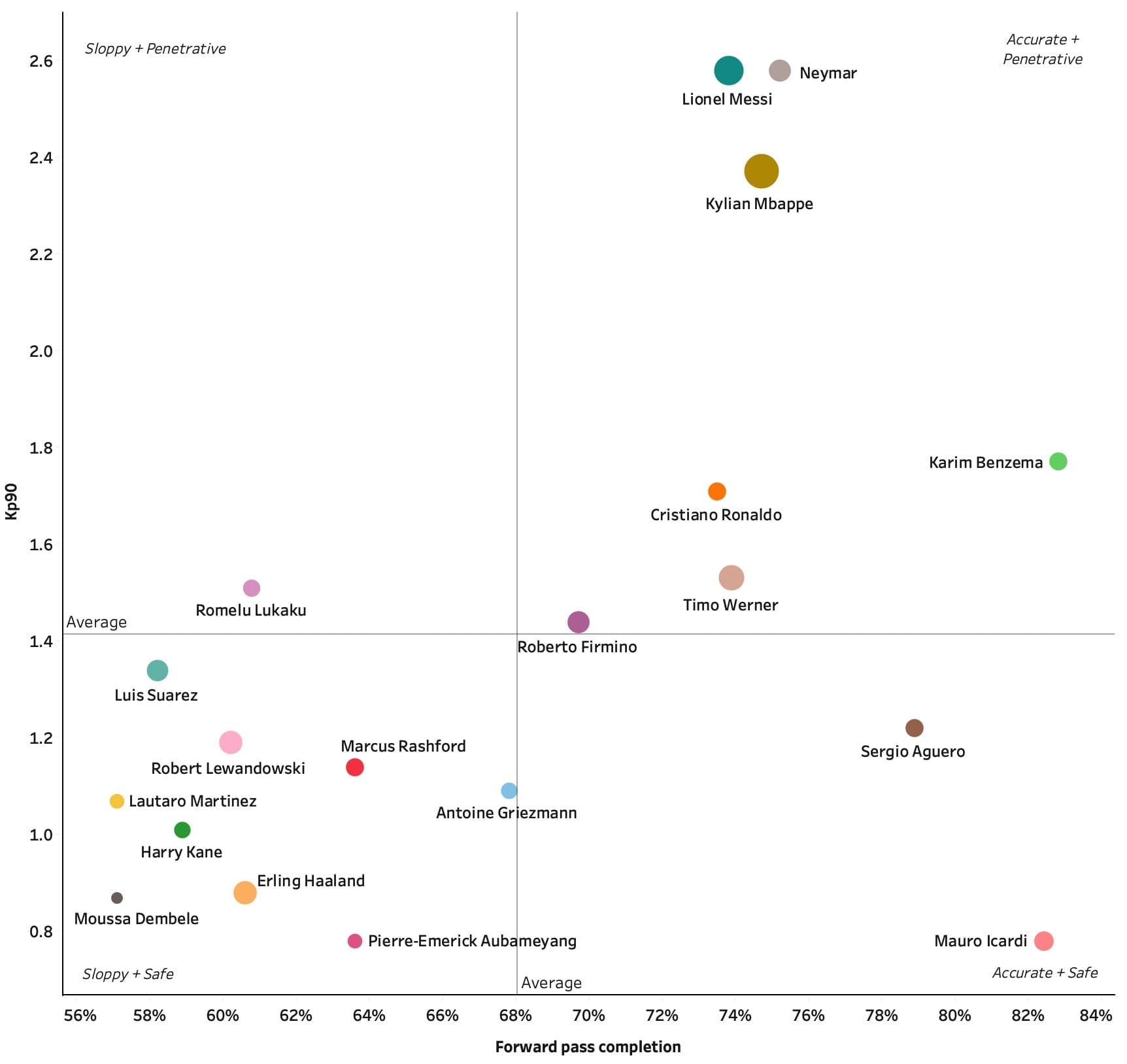
The results are slightly more favourable for Firmino but still underwhelming. The Brazilian sits just above the average for both metrics, achieving an Fp90 of 70% and 1.44 Kp90. For such a technically gifted player 70% is not surprising, Firmino is only outshone by the very best including Neymar, Lionel Messi and Kylian Mbappé. The Brazilian outperforms his Premiership rivals as well as the average of 68%. To back up his accuracy, Firimino also demonstrates penetration in his passing. His KP90 of 1.44 is better than the likes of Antoine Griezmann (1.09) and Luis Suárez (1.34) showing his ability to take risks whilst continuing to keep a high success rate.
The next graph is a variation of the metrics used above, which I ran out of interest, but the results were interesting and therefore worth including. This time I measured Kp90 against average shot assists per 90 (ShA90).
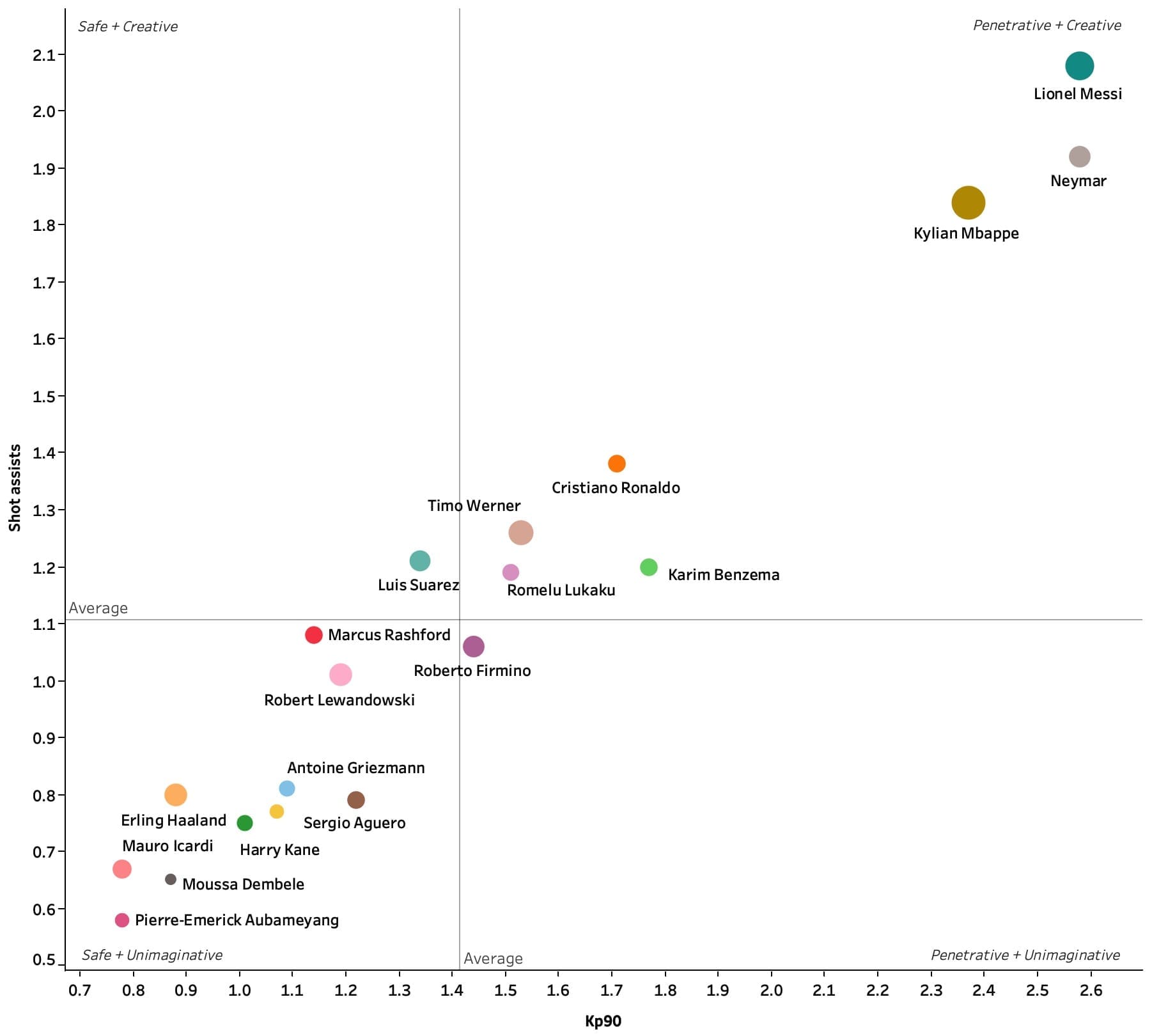
Unlike in the first graph where Firmino’s facets revealed themselves, this graph dampens the Brazilian. We can see that with ShA90 of 1.06, Firmino falls below the average of 1.1 – which in fairness is skewed by the elite three – however, he is below nearly half his rivals. Players not renowned for creativity, including Cristiano Ronaldo and Romelu Lukaku and have outperformed Firmino.
This tells us that despite the accuracy and penetration, Firmino’s passing this season has fallen short of creating openings for Liverpool to produce shots from. Liverpool’s frontman is clearly adept at keeping possession progressing from tight spaces but in terms of producing the required delivery from which to create an attempt, he is lacking.
Off the ball
The first few graphs have compared Firmino to his rivals when in possession of the football. As we all know, Liverpool’s best form of attacking is their transitions between winning and losing the ball. Bearing that in mind, I looked at metrics that measure each striker’s effectiveness out of possession.
The graph below cross-references each striker’s loose-ball duel winning percentage against their average number of recoveries made in the opposition half.
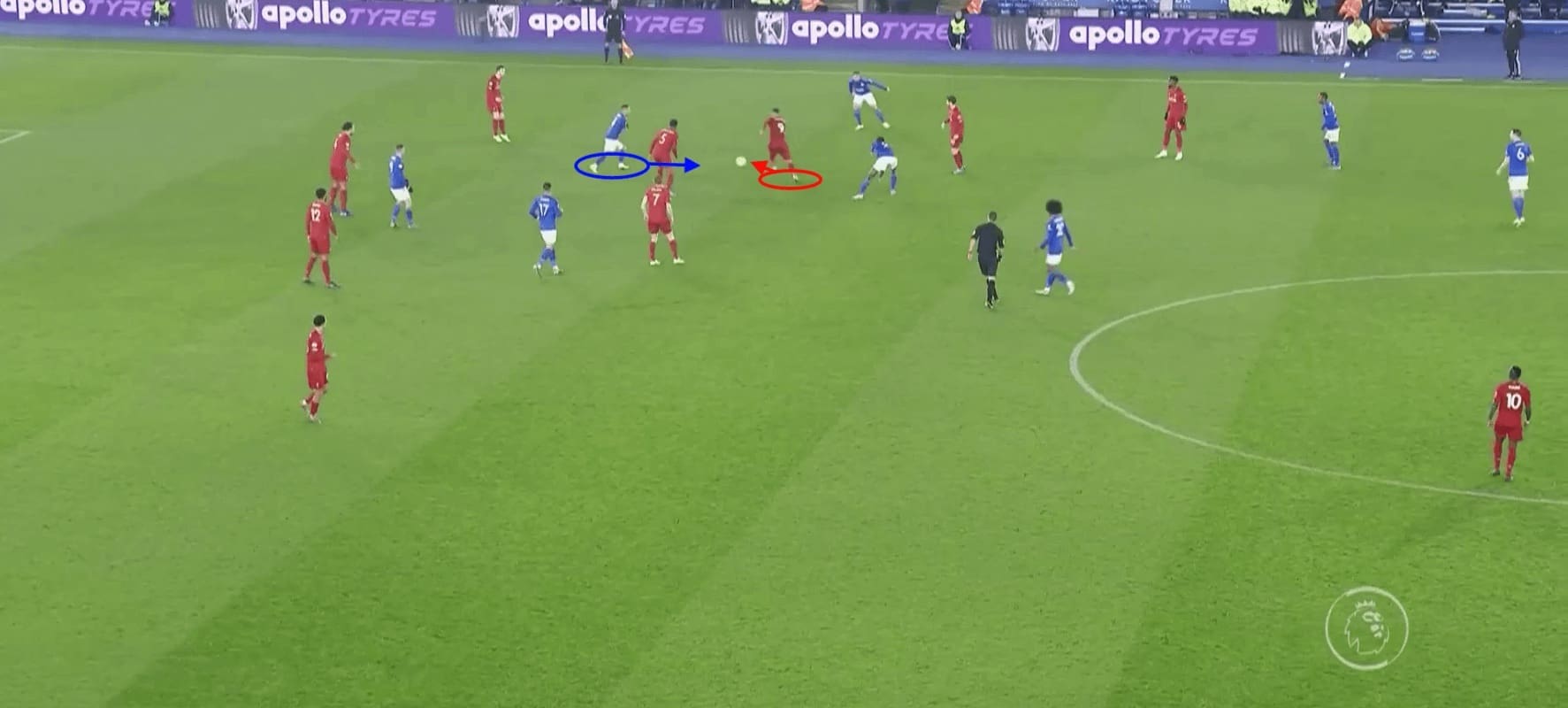
For clarification, a loose-ball duel is where possession is neutral and being contested by a player from each side – like the picture above. Measuring the success percentage of this metric gives an indication of how well the striker handles centre-backs with a combination of strength, speed and control. It is these duels that are vital to maintaining possession and sustaining attacks when the ball is being contested in the final third.
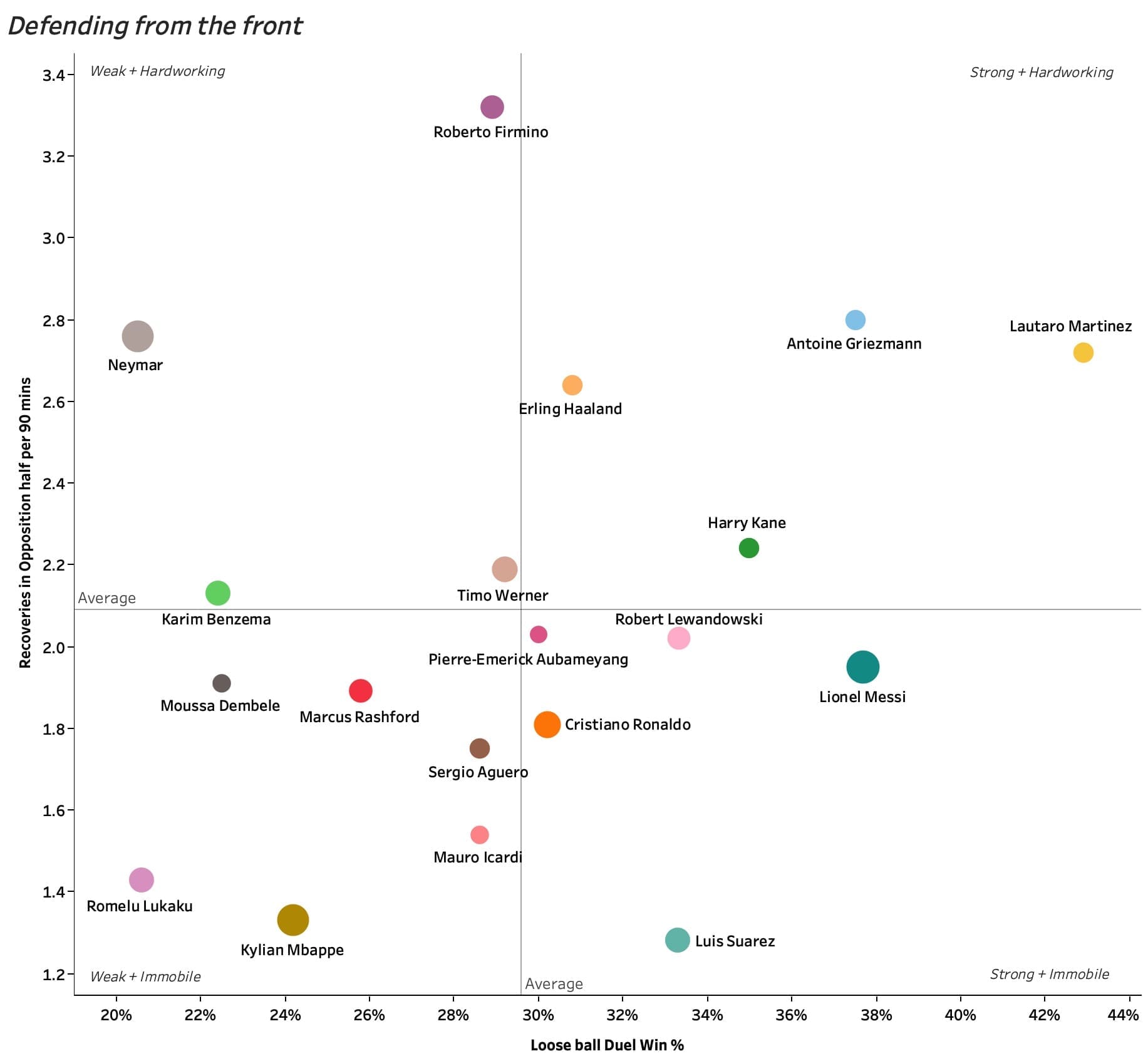
This graph identifies another area where Firmino is world-class. Averaging 3.32 recoveries in the opposition half, the striker’s speed and work-rate out of possession is unrivalled by any of the other great forwards. With the average recoveries of his counterparts being just 2.09, we can clearly see that Firmino’s skill-set goes far beyond chance creation and goalscoring.
Furthermore, despite being under the average for loose-ball duels, winning 29% of his battles against stronger/taller centre-backs is an impressive figure given the size and weight of Firmino. Bullish players such as Lautaro Martínez who wins 42% are impressive, but seeing as their styles centre around being physical compared to Liverpool intricacy and speed in transition, the necessity to win more is not apparent for Klopp’s forward.
Finishing thoughts
What we’ve learned is that Firmino is a highly nuanced player whose effectiveness cannot be measured by single metrics in isolation. The striker this season has seen a drought in goalscoring, which is usually offset by his ability to create for others. But, as we’ve also seen, these stats are not in the Brazilian’s favour. To define the Liverpool striker as underrated is now played-out, however, to label him as underperforming is also unjust.
The goals will likely return due to the higher frequency in ‘big chances’ spurned statistically likely to start hitting the net. What can be said is that Firmino can no longer rely on his metrics outside of goal-scoring as he was once hailed for, as other strikers are performing similar roles – with the added bonus of goals. Whether it’s the shift in tactics Liverpool are facing or the lack of immediate competition for his starting place, Firmino will need to step up another level if Werner walks through the door, as currently, he’s the better pick – in possession at least.





Comments